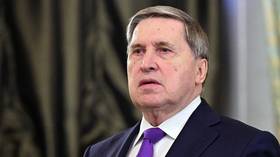Is Russia a ‘dying bear?’ After large population fall during 2020, demographic situation is worrying for Moscow, but not desperate

Like most of Europe, Russia is struggling with a falling birth rate. For Moscow, the problem is compounded by the demographic legacy of World War Two and the disastrous 1990s, but it’s doing reasonably well compared to others.
As societies grow richer, they have fewer babies. There are, of course, no infallible rules of social science. But this statement is about as close to such a rule as one is likely to find.
Across the Western world and beyond, advanced economies are experiencing a double whammy of falling birthrates and aging populations. Consequently, fewer and fewer young people are having to maintain an ever-increasing army of retirees.
The epitome of this demographic timebomb is South Korea, which this year became the first country in the world to have a fertility rate of less than one (i.e., on average, every two South Koreans are now having less than one child). But while South Korea is an extreme case, it is not completely abnormal. In general, the fertility rate in the most economically developed nations is well below that needed to keep births above deaths. In Europe, for instance, its best performing state, France, has a fertility rate of only 1.9, while the worst performing states, Malta and Spain, have rates of only 1.2, and Italy and Ukraine are not far behind with a rate of 1.3 children per couple.
Also on rt.com So long, 2020: Another year passes & despite Western predictions, warnings & wishful thinking, Russia fails to collapse... againMeanwhile, many countries in Eastern Europe have experienced massive out-migration in the past three decades. The combination of low birth rates and large-scale emigration has produced unprecedented declines in population: 25 percent in Latvia; 20 percent in Lithuania, and at least 20 percent in Ukraine (though possibly much more; accurate population data is unavailable, and Kiev has not conducted a census for 20 years).
Russia is far from immune to these processes, and it has been common for Western journalists to speak of a looming demographic disaster in the country. In 2013, for instance, British reporter Oliver Bullough published a book entitled ‘The Last Man in Russia: The Struggle to Save a Dying Nation’, which declared that “Russians are dying” and “the Russian nation is shrivelling away from within.”
This alarmist rhetoric is not justified. Russia’s fertility rate (around 1.6), while low, is at the level of the European average. Meanwhile, Russia’s population has held more or less steady over the past 30 years, declining slightly from 148 million in 1992 to just over 146 million today, albeit having previously dipped to a low of about 143 million in 2008 and then having risen again.
A number of factors explain this. The first is a steady increase in life expectancy over the past thirty years. As people live longer, fewer are dying, thus keeping the population steady. The second factor is large-scale immigration from other countries of the former Soviet Union. And a third factor is the addition of Crimea, which added a little under two million people to the Russian population.
Also on rt.com Do lockdowns reduce Covid-19 deaths? Russia's experience says perhaps not, as economy defies catastrophic trends seen elsewhereUnfortunately for Russia, however, the good times are over, and the country is now moving inexorably into a demographic trough. This became clear this week when the Russian government’s statistical service announced that the country’s population had fallen sharply in 2020 by around 560,000 people.
The most immediate reason for this decline is the Covid pandemic, which has contributed to nearly 200,000 more deaths in 2020 than in 2019, and which has also sharply curtailed immigration. The second reason is a decline in the fertility rate, which rose in the 2010s to a peak of 1.75 per couple, but has now fallen to 1.6 – a fall which may be related to stagnating incomes and the reluctance of Russians to have children they cannot afford.
The third reason is cyclical. The Russian population rises and falls in generation-length waves dating back to the Second World War, with the massive losses of that era being reproduced in new periods of relatively few births every 25 years or so. Thus, Russia experienced massive population growth after the war, which then slowed significantly in the late 1960s and early 1970s, and then went into reverse 25 years after that, in the early 1990s (a reversal accentuated by the economic crisis of the period, which led to significant declines in both births and life expectancy).
Now, another 25 years has passed since the last wave struck, meaning that Russia has entered into an unavoidable trough. It will take several years before the natural course of the cyclical process moves things back in an upwards direction.
Also on rt.com New statistics reveal that number of Russians living below poverty line jumped by 400k during Covid pandemic to 19.6 millionAware of this, the Russian government has enacted a number of measures to encourage both immigration and childbirth. The former includes making it easier for people in states of the former Soviet Union to get Russian passports. The latter includes financial incentives for couples with children, as well as expanded access to childcare facilities.
The importance given to the subject can be seen by the fact that in both 2019 and 2020, Russian President Vladimir Putin devoted significant sections of his annual speech to the Federal Assembly to policies designed to encourage Russians to have children. However, the fact that Putin felt obliged to return to the topic in 2020 was evidence that the steps outlined in 2019 had proven ineffective. To date, his pro-natalist policies are not having any obvious impact – in fact, since they were introduced, fertility in Russia has actually declined.
In part, this is due to economic reasons, most notably the fact that Russian incomes have stagnated, or even fallen, in recent years. A few additional financial incentives from the state cannot compensate for the lack of money in people’s pockets in the first place.
Beyond this, modern societies do not encourage large families. Young people are in education for longer, thus postponing marriage and children. Women have more career opportunities, producing similar results. And children are expensive. State assistance can do something about the last factor, but can only mitigate it, not eliminate it. Meanwhile, the first two factors are largely beyond the state’s power. Even the strongest ruler can’t force his people to have children.
Also on rt.com Russia's population decline accelerated in 2020, losing 500,000 residents amid Covid deaths, falling birth rate & less immigrationIn short, the Russian government is swimming against a tide which is probably too strong for it. This does not mean that Russia’s demographic situation is desperate. In fact, by European standards, Russia is doing reasonably well. And by the standards of other European parts of the former Soviet Union, it is doing very well. But still, some degree of demographic decline during the next decade is inevitable. This helps explain why Putin, like the leaders of many other European countries, took the unpopular step of raising the pensionable age. As fewer Russians are born, and more live for longer, Russia is going to have to learn to adapt.
Think your friends would be interested? Share this story!
The statements, views and opinions expressed in this column are solely those of the author and do not necessarily represent those of RT.
The statements, views and opinions expressed in this column are solely those of the author and do not necessarily represent those of RT.















